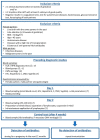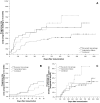Live Birth Rates after Active Immunization with Partner Lymphocytes
- PMID: 34680467
- PMCID: PMC8533392
- DOI: 10.3390/biomedicines9101350
Live Birth Rates after Active Immunization with Partner Lymphocytes
Abstract
Although many potential causes have been established for recurrent implantation failure (RIF) and recurrent miscarriage (RM), about 50% of these remain idiopathic. Scientific research is focused on immunological risk factors. In the present study, we aim to evaluate live birth rates after immunization with paternal lymphocytes (lymphocyte immunotherapy (LIT)). This retrospective study consisted of 148 couples with a history of RM and/or RIF. The women underwent immunization with lymphocytes of their respective partners from November 2017 to August 2019. Fifty-five patients (43%) had live births. Stratified by indication (RM, RIF, combined), live birth rates in the RM and the combined group were significantly higher than that in the RIF group (53%, 59% and 33%, respectively, p = 0.02). The difference was especially noticeable during the first 90 days after immunization (conception rate leading to live births: 31%, 23% and 8% for RM, the combined group and RIF, respectively; p = 0.005), while there was no difference between groups during the later follow-up. LIT was associated with high live birth rates, especially in women with recurrent miscarriage. In view of the limited data from randomized studies, LIT cannot be recommended as routine therapy. However, it may be considered in individual cases.
Keywords: immunization; implantation failure; live birth rate; paternal lymphocytes; recurrent miscarriage.
Conflict of interest statement
The authors declare no conflict of interest.
Figures


Similar articles
-
Preimplantation genetic testing for aneuploidy: a comparison of live birth rates in patients with recurrent pregnancy loss due to embryonic aneuploidy or recurrent implantation failure.Hum Reprod. 2019 Dec 1;34(12):2340-2348. doi: 10.1093/humrep/dez229. Hum Reprod. 2019. PMID: 31811307
-
Maternal KIR haplotype influences live birth rate after double embryo transfer in IVF cycles in patients with recurrent miscarriages and implantation failure.Hum Reprod. 2014 Dec;29(12):2637-43. doi: 10.1093/humrep/deu251. Epub 2014 Oct 14. Hum Reprod. 2014. PMID: 25316448
-
Lymphocyte immunotherapy in the treatment of recurrent miscarriage: systematic review and meta-analysis.Arch Gynecol Obstet. 2017 Feb;295(2):511-518. doi: 10.1007/s00404-016-4270-z. Epub 2016 Dec 21. Arch Gynecol Obstet. 2017. PMID: 28004193
-
Lymphocyte immunotherapy in recurrent miscarriage and recurrent implantation failure.Am J Reprod Immunol. 2021 Apr;85(4):e13408. doi: 10.1111/aji.13408. Epub 2021 Mar 10. Am J Reprod Immunol. 2021. PMID: 33638199
-
Time to conception and time to live birth in women with unexplained recurrent miscarriage.Hum Reprod. 2014 Jun;29(6):1146-52. doi: 10.1093/humrep/deu052. Epub 2014 Mar 28. Hum Reprod. 2014. PMID: 24682612 Clinical Trial.
Cited by
-
Immune Cell Functionality during Decidualization and Potential Clinical Application.Life (Basel). 2023 Apr 27;13(5):1097. doi: 10.3390/life13051097. Life (Basel). 2023. PMID: 37240742 Free PMC article. Review.
-
Alloimmune Causes of Recurrent Pregnancy Loss: Cellular Mechanisms and Overview of Therapeutic Approaches.Medicina (Kaunas). 2024 Nov 19;60(11):1896. doi: 10.3390/medicina60111896. Medicina (Kaunas). 2024. PMID: 39597081 Free PMC article. Review.
-
Recurrent implantation failure: A comprehensive summary from etiology to treatment.Front Endocrinol (Lausanne). 2023 Jan 5;13:1061766. doi: 10.3389/fendo.2022.1061766. eCollection 2022. Front Endocrinol (Lausanne). 2023. PMID: 36686483 Free PMC article. Review.
-
MTR, MTRR and CBS Gene Polymorphisms in Recurrent Miscarriages: A Case Control Study from North India.J Hum Reprod Sci. 2022 Apr-Jun;15(2):191-196. doi: 10.4103/jhrs.jhrs_186_21. Epub 2022 Jun 30. J Hum Reprod Sci. 2022. PMID: 35928461 Free PMC article.
-
Molecular Determinants of Uterine Receptivity: Comparison of Successful Implantation, Recurrent Miscarriage, and Recurrent Implantation Failure.Int J Mol Sci. 2023 Dec 18;24(24):17616. doi: 10.3390/ijms242417616. Int J Mol Sci. 2023. PMID: 38139443 Free PMC article. Review.
References
-
- WHO WHO: Recommended definitions, terminology and format for statistical tables related to the perinatal period and use of a new certificate for cause of perinatal deaths. Modifications recommended by FIGO as amended October 14, 1976. Acta Obstet. Gynecol. Scand. 1977;56:247–253. - PubMed
LinkOut - more resources
Full Text Sources

